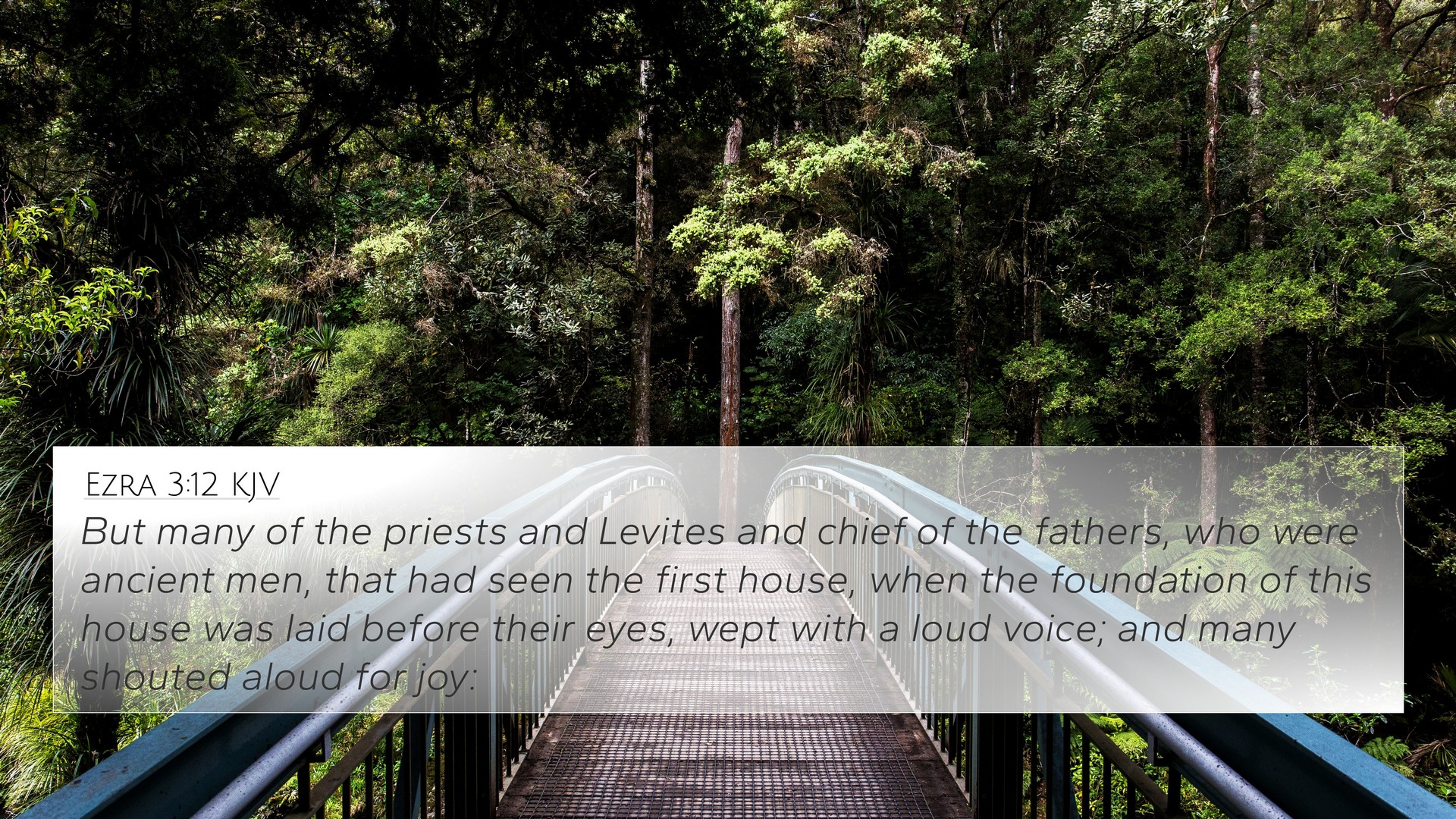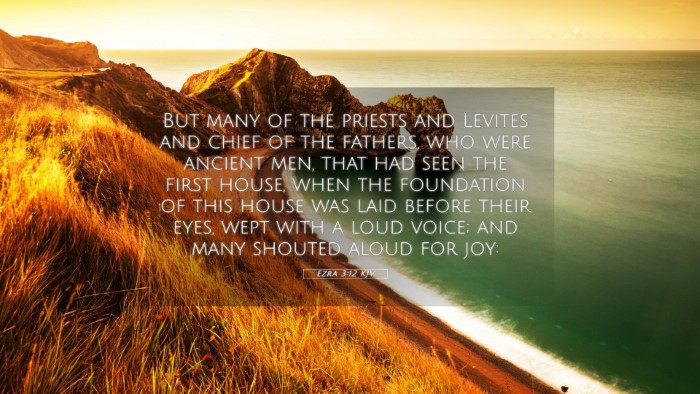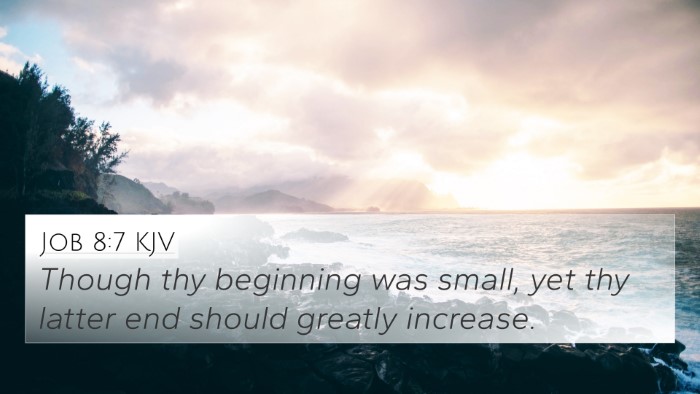Old Testament
Genesis Exodus Leviticus Numbers Deuteronomy Joshua Judges Ruth 1 Samuel 2 Samuel 1 Kings 2 Kings 1 Chronicles 2 Chronicles Ezra Nehemiah Esther Job Psalms Proverbs Ecclesiastes Song of Solomon Isaiah Jeremiah Lamentations Ezekiel Daniel Hosea Joel Amos Obadiah Jonah Micah Nahum Habakkuk Zephaniah Haggai Zechariah MalachiEzra 3:12 Similar Verses
Ezra 3:12 Cross References
But many of the priests and Levites and chief of the fathers, who were ancient men, that had seen the first house, when the foundation of this house was laid before their eyes, wept with a loud voice; and many shouted aloud for joy:
Uncover the Rich Themes and Topics of This Bible Verse
Listed below are the Bible themes associated with Ezra 3:12. We invite you to explore each theme to gain deeper insights into the Scriptures.
Ezra 3:12 Cross Reference Verses
This section features a detailed cross-reference designed to enrich your understanding of the Scriptures. Below, you will find carefully selected verses that echo the themes and teachings related to Ezra 3:12 KJV. Click on any image to explore detailed analyses of related Bible verses and uncover deeper theological insights.
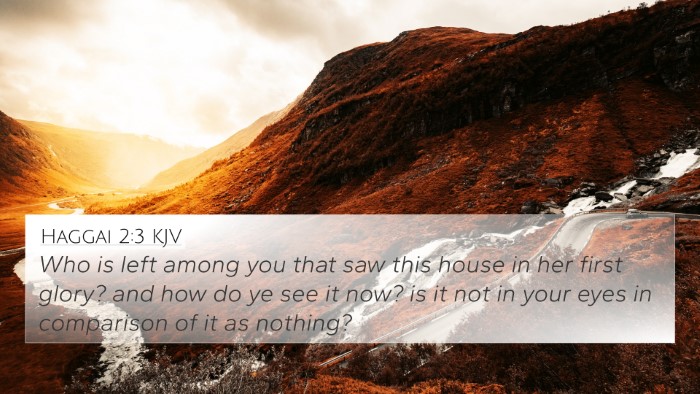
Haggai 2:3 (KJV) »
Who is left among you that saw this house in her first glory? and how do ye see it now? is it not in your eyes in comparison of it as nothing?
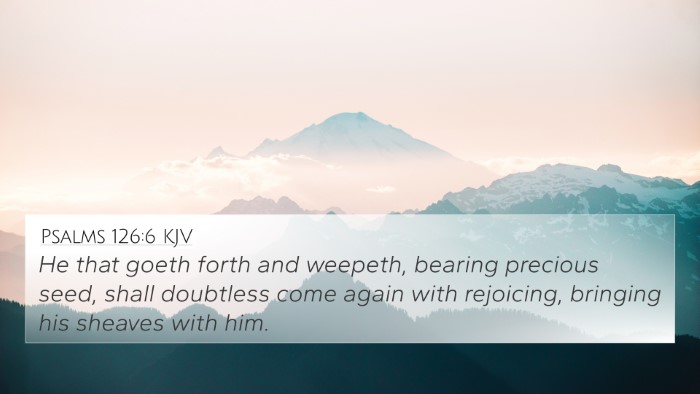
Psalms 126:6 (KJV) »
He that goeth forth and weepeth, bearing precious seed, shall doubtless come again with rejoicing, bringing his sheaves with him.
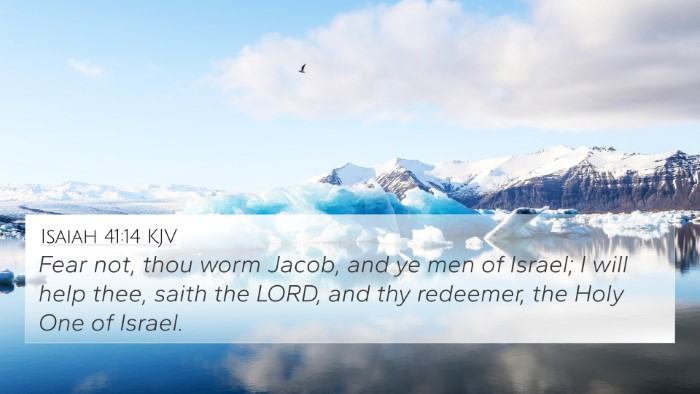
Isaiah 41:14 (KJV) »
Fear not, thou worm Jacob, and ye men of Israel; I will help thee, saith the LORD, and thy redeemer, the Holy One of Israel.
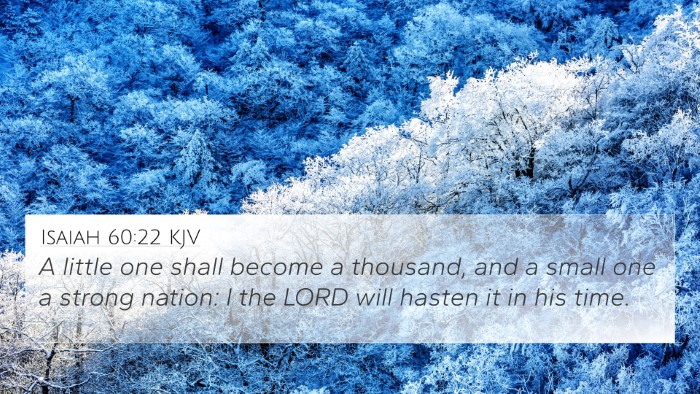
Isaiah 60:22 (KJV) »
A little one shall become a thousand, and a small one a strong nation: I the LORD will hasten it in his time.

Jeremiah 31:8 (KJV) »
Behold, I will bring them from the north country, and gather them from the coasts of the earth, and with them the blind and the lame, the woman with child and her that travaileth with child together: a great company shall return thither.
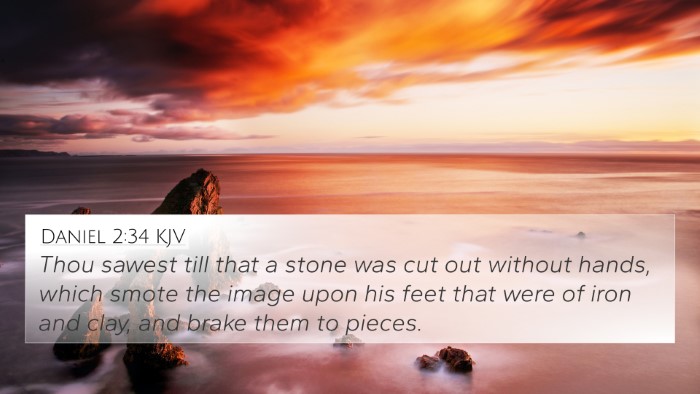
Daniel 2:34 (KJV) »
Thou sawest till that a stone was cut out without hands, which smote the image upon his feet that were of iron and clay, and brake them to pieces.
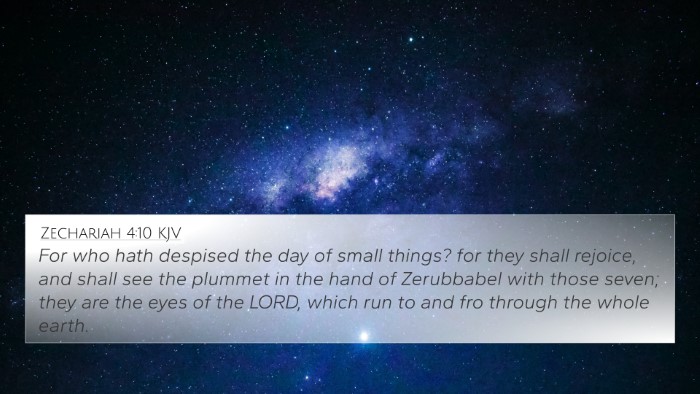
Zechariah 4:10 (KJV) »
For who hath despised the day of small things? for they shall rejoice, and shall see the plummet in the hand of Zerubbabel with those seven; they are the eyes of the LORD, which run to and fro through the whole earth.
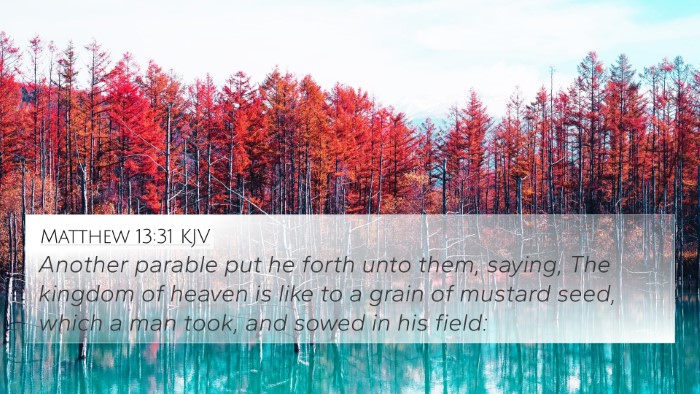
Matthew 13:31 (KJV) »
Another parable put he forth unto them, saying, The kingdom of heaven is like to a grain of mustard seed, which a man took, and sowed in his field:
Ezra 3:12 Verse Analysis and Similar Verses
Understanding Ezra 3:12
Verse: Ezra 3:12 - "But many of the priests and Levites and chief of the fathers, who were ancient men, that had seen the first house, when the foundation of this house was laid before their eyes, wept with a loud voice; and many shouted aloud for joy."
Summary of Meaning
Ezra 3:12 captures a poignant moment in the history of Israel as they return from exile and begin the reconstruction of the Temple. The contrasting emotions displayed by the people highlight the significance of this event in their spiritual and communal identity.
Insights from Commentaries
-
Matthew Henry:
Henry notes how the age of the priests and Levites influenced their emotional response to the laying of the foundation. Those who had witnessed the grandeur of the first Temple were overwhelmed by its diminutive replacement, evoking sorrow rather than joy. The older generation's tears serve as a reminder of loss and memory.
-
Albert Barnes:
Barnes emphasizes the unity of the people in their reactions. While some wept, others rejoiced, showing the complexity of communal emotions in response to God's work. This duality illustrates the varied perspectives within God's people, symbolizing both hope and nostalgia.
-
Adam Clarke:
Clarke brings attention to the historical context, noting that the glory of the first Temple made it difficult for the returning exiles to fully appreciate the new Temple. This verse demonstrates the challenges of comparing past glories with present realities in spiritual life.
Emotional Impact and Significance
The Israelites faced a unique emotional landscape as they stood before the newly laid foundation of the Temple. This moment signifies not only the physical act of rebuilding but also the reconsolidation of their identity as God's people. The tears of the elders symbolize deep nostalgia, whereas the shouts of joy represent hope for future restoration and fulfillment of God’s promises.
Cross-References
This verse connects deeply with various other scriptures that shed light on similar themes of rebuilding, memory, and communal emotional experiences:
- Haggai 2:3: “Who is left among you that saw this house in her first glory? And how do ye see it now? is it not in your eyes in comparison of it as nothing?”
- Isaiah 61:4: “And they shall build the old wastes, they shall raise up the former desolations, and they shall repair the waste cities, the desolations of many generations.”
- Zechariah 8:12: “For the seed shall be prosperous; the vine shall give her fruit, and the ground shall give her increase, and the heavens shall give their dew; and I will cause the remnant of this people to possess all these things.”
- Psalms 126:1-3: “When the LORD turned again the captivity of Zion, we were like them that dream... The LORD hath done great things for us; whereof we are glad.”
- Nehemiah 8:9-10: “For all the people wept, when they heard the words of the Law.”
- Lamentations 5:19-21: “Thou, O LORD, remainest forever; thy throne from generation to generation... Restore us to thyself, O LORD, that we may be restored.”
- Revelation 21:4: “And God shall wipe away all tears from their eyes; and there shall be no more death, neither sorrow, nor crying, neither shall there be any more pain...”
Thematic Connections
Ezra 3:12 highlights themes found throughout scripture, including:
- Rebuilding and Restoration: The theme of restoration is pivotal across the Bible, especially concerning God’s covenant with His people.
- Nostalgia and Memory: Reflecting on past glory informs present faith and future hope—an essential biblical principle.
- Community Response: The collective emotional experience of God’s people emphasizes the importance of unity in worship and remembrance.
Practical Applications
This verse encourages believers today to acknowledge their past while embracing the present moments. The emotional dichotomy experienced by the people serves as a reminder that both joy and sorrow can coexist in the life of faith. Here are some reflective applications:
- Remembering God's Faithfulness: Reflect on past experiences of God’s provision.
- Embracing New Beginnings: Recognize that new foundations in life can produce different yet equally important aspects of faith.
- Fostering a Community of Support: Share in one another's joys and sorrows within a community of believers.
Conclusion
Ezra 3:12 serves as a powerful reminder of the complex emotions involved in the spiritual journey. By examining this verse and its connections to other parts of Scripture, believers can find hope, healing, and a deeper understanding of God’s work in their lives. The echoes of nostalgia and the shouts of joy can coexist, fostering a rich experience of faith as they await the fulfillment of God's promises.
SEO Keywords
This exploration of Ezra 3:12 reflects thematically on various keywords that enhance understanding, including:
- Bible verse parallels
- Bible verse cross-references
- Connecting Bible verses
- Bible concordance
- Understanding thematic Bible verse connections
- Comparative Bible verse analysis
